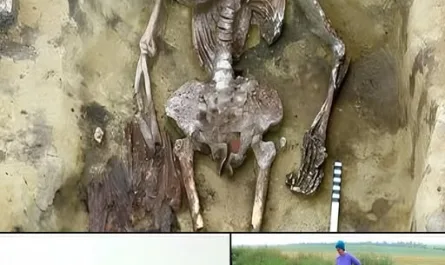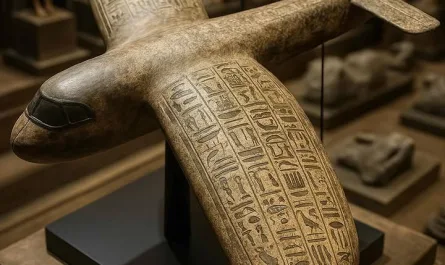An Unusual Discovery
On a crisp morning in 1897, an extraordinary image emerged, claiming to capture a remarkable scene in Jerusalem. The black-and-white photograph reveals a colossal rock formation, seemingly hewn from the earth itself, suspended improbably above the ground. This natural marvel is supported by a cluster of intricately carved columns, their surfaces adorned with subtle reliefs that hint at ancient craftsmanship. Above, the underside of the rock features an ornate ceiling, decorated with elaborate patterns reminiscent of Middle Eastern artistry, complete with floral motifs and geometric designs. Below this awe-inspiring structure, a large crowd of people—dressed in robes typical of the late 19th century—gathers, their faces turned upward in what appears to be a mixture of reverence and curiosity. The backdrop reveals a vast, rugged landscape of rolling hills and distant mountains, bathed in soft light, adding to the surreal atmosphere.

Fact or Fantasy?
Despite its striking detail, this image raises significant questions about its authenticity. Jerusalem in 1897, under Ottoman rule, was a city known for its religious significance and historical architecture, such as the Dome of the Rock and the Western Wall. However, no historical records or archaeological evidence support the existence of such a massive, cantilevered rock structure supported by columns. The engineering feat required to create and maintain such a formation would have been extraordinary, far beyond the capabilities of the period. Experts suggest this is likely an artistic illustration or a conceptual piece, possibly commissioned to evoke the grandeur of biblical stories like the Temple of Solomon or the visions of prophets. The photographic style, with its dramatic contrasts and composition, also aligns with the artistic trends of the time, such as those seen in early cinematic or theatrical set designs.
The Allure of the Unknown
This enigmatic image invites speculation and wonder. Could it be an early example of photo manipulation, a technique that was emerging in the late 19th century with pioneers like Henry Peach Robinson? Or perhaps it was intended as a fantastical depiction for a storybook or religious text, blending reality with imagination. The crowd’s presence suggests a communal event—maybe a staged gathering to lend credibility to the scene. The interplay of natural and man-made elements, from the raw rock to the polished columns, creates a narrative that feels both timeless and otherworldly. For historians, artists, and dreamers alike, it serves as a canvas for exploring the boundaries between fact and fiction.
Cultural and Historical Context
In 1897, Jerusalem was a melting pot of cultures, with Jewish, Christian, and Muslim communities coexisting under Ottoman governance. The city was also gaining attention from Western explorers and photographers, who documented its landscapes and monuments. This image might reflect the romanticized views of the Holy Land prevalent in Europe and America during the Victorian era, where artists often exaggerated or invented scenes to captivate audiences. The use of black-and-white photography, a dominant medium at the time, enhances the image’s ethereal quality, making it feel like a glimpse into a lost world.
Conclusion
The mysterious rock formation of 1897 Jerusalem remains an unsolved puzzle. Whether it’s a product of artistic ingenuity, a misattributed artifact, or a deliberate fabrication, it continues to captivate those who encounter it. It challenges us to question our perceptions of history and invites further exploration into the creative minds of the past. What do you think—could this be a forgotten wonder, or is it a masterful blend of myth and artistry? Share your thoughts as we continue to unravel the stories hidden within this striking image.





